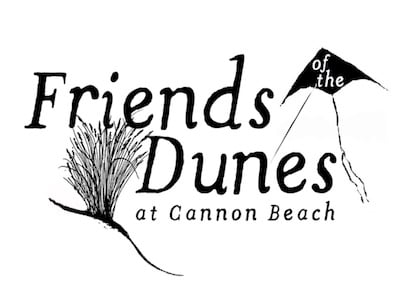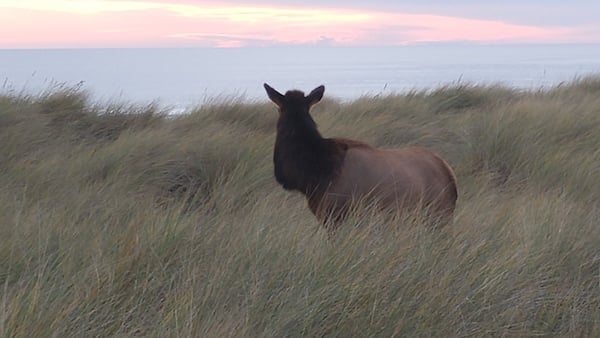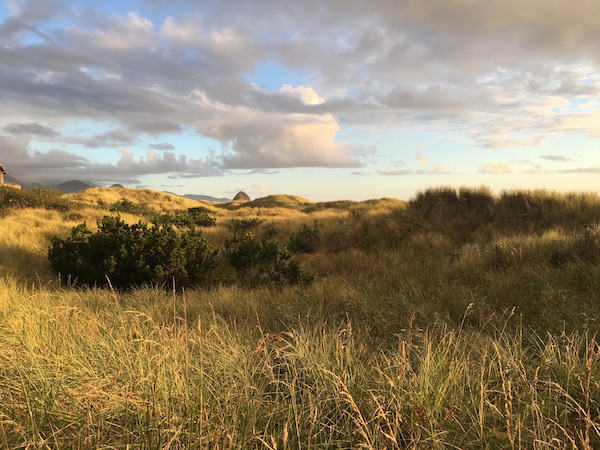
Given our fair state's love affair with our public beaches, you'd think we might have a greater appreciation, respect and understanding for sand. But in Oregon we've historically approached sand as a resource which we can mine, move, build into dunes and grade back down again. Yes we have a beautiful Beach Bill and Statewide Planning Goal 18 , but the aspirations of these policies can often fall short, compromised to the political will of ocean front homeowners and developers.
In 1984, Goal 18 was amended to allow for grading of dunes for "view enhancement", opening up a pandora's box just in time for one of our greatest El Nino erosion years in recent history. Many coastal communities where oceanfront development has been permitted close enough to the beaches now grapple with some form of erosion, too little sand, or too much sand that requires active management.
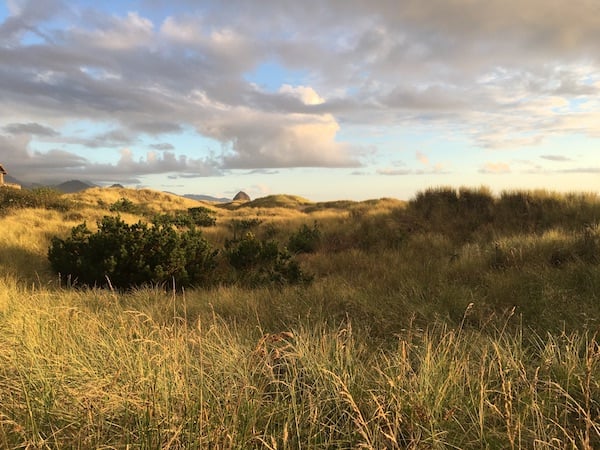 Haystack Rock peaks out behind the rolling hummocks of dunes at the north end of Cannon Beach, Photo: Clay Newton
Haystack Rock peaks out behind the rolling hummocks of dunes at the north end of Cannon Beach, Photo: Clay Newton
Where dynamic sand movement occurs along our beaches and static homes exist...the Oregon coast sand paradigm continues. Below we present one such paradigm on the Oregon coast through a guest blog on the current conundrum in Cannon Beach:
Trading Dunes for Ocean Views
By Dianna Turner, Friends of the Dunes at Cannon Beach
The city of Cannon Beach is known as the jewel of the north coast for its art galleries, restaurants and boutiques. But as charming as the town is, the real draw remains the jaw-dropping beauty of the coastline. Between the ocean and the town is a healthy dune system. The spectacular dunes provide a home for plants and animals, a place to recreate, and a strong defense against storms. They’re planted with European beach grass, which is the only variety shown to strongly anchor dunes when permanent structures are built nearby. The beach grass, then, provides both beauty and security for the dunes and the town. Though European beach grass is an invasive, (only in that it’s from Europe,) it is a necessary compromise in built-up areas to stabilize dunes.
 Foredunes at the north end of Cannon Beach are stabilized by European beach grass. Photo: Jeff Harrison
Foredunes at the north end of Cannon Beach are stabilized by European beach grass. Photo: Jeff Harrison
In scientific speak, the front lines of dunes are called active foredunes. That’s because sand dunes move: they’re active. Yet for some, nature presented a problem. Up to the late 1990s, the Cannon Beach foredunes had eroded so much that residents were concerned about losing them completely, leaving the town little protection against storms. But then the sand patterns shifted, as they do, and the dunes began to grow again, especially at the northern end of town.
And so it begins
In 1998, Cannon Beach bowed to the demands of ocean-front home owners and began allowing dune grading for view enhancement. (Or as they like to say: “view restoration.” ) That year Breakers Point Homeowners Association requested, and received, permission to grade the state-owned foredunes in front of their development. They provided a small, localized sand study to the City as part of their application. Eighteen years later, that sand study was still the only one Cannon Beach used, and it was enshrined in the city’s comprehensive plan. The study was meant to have only a 10-year life. Since 1998, the City has granted multiple permits for foredune grading to Breakers Point Homeowners Association and Oceanside Homeowners Association, in the area know as the “Presidential Streets.” The grading requests have ranged from 4,000 to 8,000 cubic yards. The unwanted graded sand was usually pushed out to the intertidal zone with hopes that it would wash out to sea, but with the knowledge that it would eventually return to the beach. We now know that this practice of sand dumping drowns the razor clams that live at the tideline.
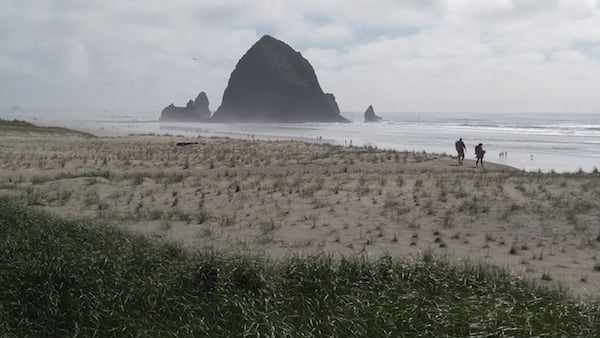 Post dune grading with replanted European beach grass...the cycle continues. An improved view for some and blight for others. Photo: Jeff Harrison
Post dune grading with replanted European beach grass...the cycle continues. An improved view for some and blight for others. Photo: Jeff Harrison
Give an inch…
Flash forward to 2014 when Breakers Point requested a dune grading permit for up to 74,000 cubic yards of sand — ten times more than previously allowed! This floored the community and galvanized a group of concerned neighbors to join together to fight this land-grab of state property. We named ourselves the Friends of The Dunes. Together with Oregon Coast Alliance, we opposed this request. Thankfully, both the planning commission and city council turned down this audacious proposal by Breakers Point.
Since then, Breakers Point has continued to apply for dune-grading permits and we have continued to lobby our city policy makers to remember that the dunes belong to all of us and are not to be scraped and dumped to please a group of vocal property owners.
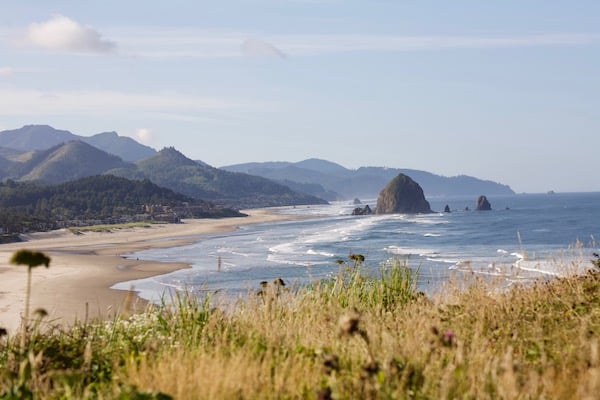 The dynamic beach front of Cannon Beach attracts millions of beachgoers each year. Photo: Clay Newton
The dynamic beach front of Cannon Beach attracts millions of beachgoers each year. Photo: Clay Newton
Finally, a new sand study
Cannon Beach commissioned the Department of Geology and Mineral Industries (DOGAMI) to conduct an expensive study of sand movement within the entire Cannon Beach littoral cell from Cape Falcon to Chapman Point Beach. The draft study was completed in late 2017, and was to be used to inform a revision of the 20-year old Foredune Management Plan.
The future of the dunes
The City of Cannon Beach also held public hearings and hired the Columbia River Estuary Task Force (CREST) to write a draft of the new sand management plan. Unfortunately, the city directed CREST to draft recommendations with the assumption that Cannon Beach would continue to allow dune-grading for view enhancement. This outraged the Friends of the Dunes, who expected that a policy change to disallow dune grading for view enhancement would be considered.
Where are we now?
The planning commissioners deliberated for the first time at the July meeting and will continue their deliberation in August. We are encouraged that the commissioners spoke of the possibility of discontinuing dune grading. In fact, chairman Lundy started their deliberation by asking if the commissioners wanted to immediately vote on recommending no dune grading to the city councilors. The commissioners decided, however, to deliberate so as to have a thorough record to refer to the city council, who will ultimately make the final decision.
The timing couldn’t be better
City council will soon be reviewing the city’s comprehensive plan. This is the governing document that currently allows dune grading for homeowner view enhancement. During this review process the councilors have the ability to remove this provision, thereby ending dune grading for that purpose. We believe this is the right decision for a number of reasons, including:
*The dunes belong to the State of Oregon, not self-concerned property owners.
*The dunes are a valuable public asset, enjoyed by residents and visitors alike.
*The dunes are a crucial part of the Cannon Beach’s economy and beauty.
*The dunes provide a critical bulwark against storm-damage and flooding, absorbing ever-increasingly strong, king tide waves.
*The city’s stated goal to protect the dunes as a habitat for plants and animals.
For the first time in twenty years, we have within our reach this crucial change to Cannon Beach’s Comprehensive Plan!
How can I help?
Join us in telling the city councilors that the foredunes belong to all of us, in addition to the plants and animals who call them home. Tell the City of Cannon Beach that “the view” to protect is the one of the dunes from the beach, which is enjoyed by thousands of visitors and residents every year.
Helpful links:
Friends of Dunes Petition: Sign the Petition!
Contact The Friends of the Dunes at Cannon Beach: friendsofdunes@gmail.com
Oregon Coast Alliance website. Check the newsletter archives for more info.
Write to City of Cannon Beach City Councilors Contact info. here.